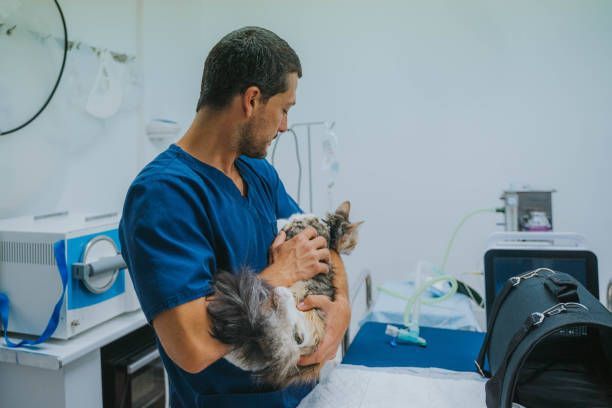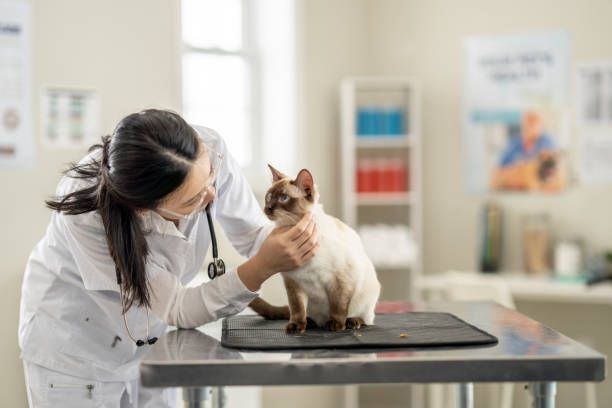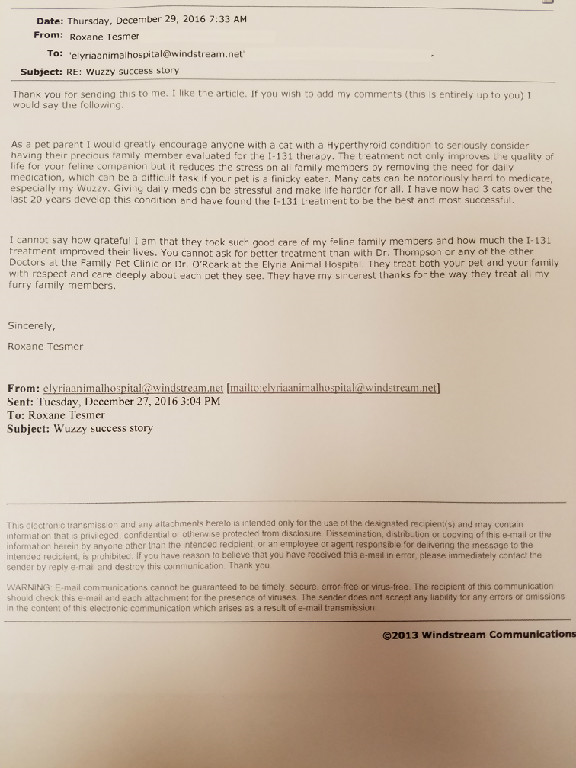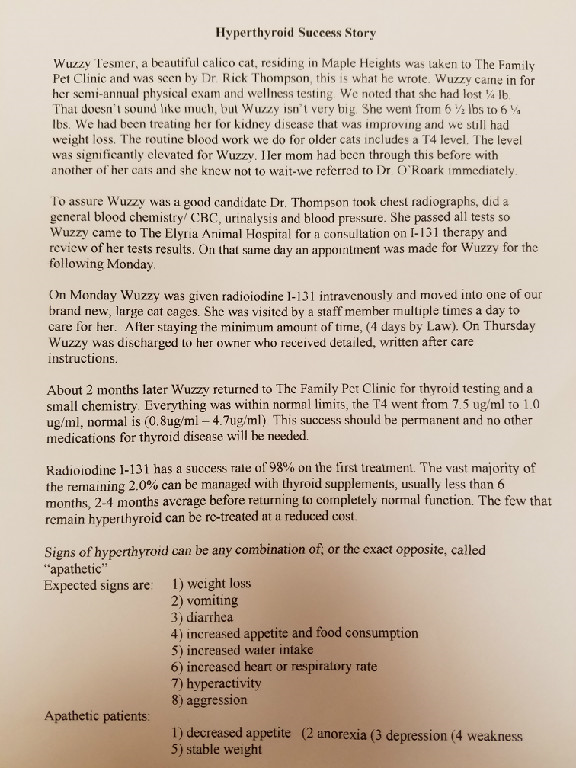Radioactive Iodine Therapy (I-131)
Treatment with Radioactive Iodine (I-131) is the preferred treatment for feline hyperthyroidism (as well as in humans). It is as easy as one injection just under the skin, much like a routine feline vaccine. I-131 is safe and effective. A short stay (3 to 10 days) in the treatment room facility is required by law until the level of radiation is at an acceptable level.
The I-131 is absorbed quickly into the cat's bloodstream and the diseased thyroid tissue. Once in the thyroid, it destroys the overactive portions of the thyroid gland. The radiation is excreted through the urine and feces, and a safe level of radioactivity is obtained within 3 to 10 days.
I-131 treatment has advantages over medical and surgical treatments for feline hyperthyroidism.
No anesthesia is required
No daily medication
Does not destroy healthy tissue
Does not damage other tissues or organs, including the parathyroid glands
Does not have harmful side effects
Returns thyroid function to normal usually within one month
Is cost-effective
Our Treatment room is an approved specialty facility with State Department of Health and Nuclear Regulatory Commission permits for use of I-131.
General Information
Hyperthyroidism And I-131 Therapy in Cats
- Hyperthyroidism is a commonly diagnosed endocrine pathology in older cats. It is caused by a tumor that produces too much feline thyroid hormone. It is usually fatal if left untreated.
- Feline Hyperthyroidism may be treated with medicine, surgery, or radioactive iodine:
- Medical therapy (methimazole - Tapazole®) is required daily, is a life-long treatment, and does not cure the cat's condition. The difficulties associated with giving pills to cats often cause stress to both the animal and the owner. Tapazole may have side effects, especially relative to the liver and blood systems. The drug therapy must be adjusted based on periodic blood tests, and the cost of therapy and tests is usually over $800 per year.
- Surgical therapy requires anesthesia, may need to be repeated, and may result in a deficiency of parathyroid hormone if these glands are inadvertently removed. Surgery may not be effective in removing all of the affected thyroid tissue.
- Radioactive Iodine (I-131) therapy is very effective, has few side effects, is a one-time treatment in over 95% of animals, and does not require the administration of pills or anesthesia. One injection under your cat's skin is all that is needed! The cost of radioactive iodine therapy is similar to the other forms of therapy and is often less expensive when compared to long-term medical therapy or the higher probability of a required second surgery.
- Prior to making a final decision relative to initiating the I-131 therapy, all cats are screened closely for the presence of other illnesses, including cardiovascular and kidney disease. The usual screening tests include a complete blood count, serology, urinalysis, radiographs, and ultrasound. Your primary care veterinarian performs most of the routine tests prior to the final evaluation. The x-rays and results of the routine tests are reviewed by the specialists at Thyro-Cat, and the results of your cat's tests are discussed with your veterinarian.
- If appropriate, a methimazole (Tapazole) trial should be conducted to assess the potential for unmasking renal disease that may have been obscured by the hyperthyroid state.
- This trial is performed by giving methimazole (Tapazole) at an adequate dose to induce a euthyroid state for at least two (2) weeks – this is determined by monitoring the blood T4 value.
- Once the pet has been euthyroid for two weeks while on methimazole, renal function is assessed by evaluating the BUN, creatinine, and urine-specific gravity values.
- If the laboratory findings indicate stable renal function in the euthyroid pet while being given methimazole, then there is a greater probability the patient will have stable renal function following I-131 therapy.
- Methimazole therapy should be stopped at least seven (7) days prior to I-131 therapy.
- If your cat is an appropriate candidate for I-131 therapy, an appointment is made for you to bring your pet to our facility. Your pet is examined, and, if necessary, a cardiac and abdominal ultrasound evaluation is performed. If I-131 therapy is appropriate, your cat is admitted to the program, given the medication, and monitored closely for the next 3 to 10 days.
Take the First Step to a Healthier Cat
Don't let hyperthyroidism affect your feline friend's quality of life. Contact us at (440) 365-3818 to schedule a consultation and explore the benefits of I-131 treatment. Your cat deserves a happier, healthier tomorrow.












